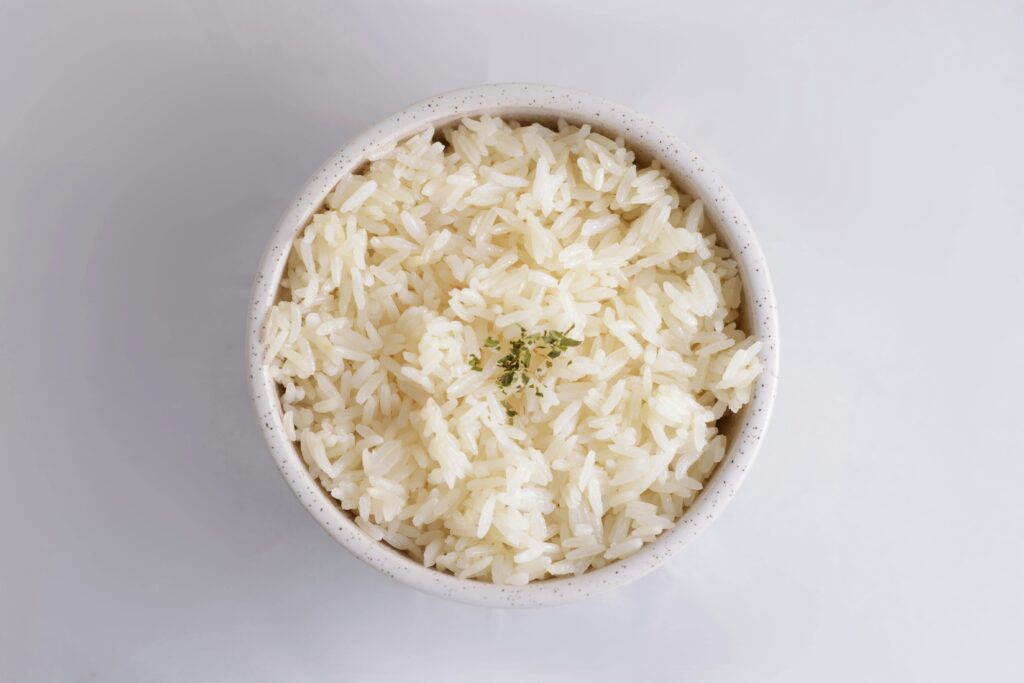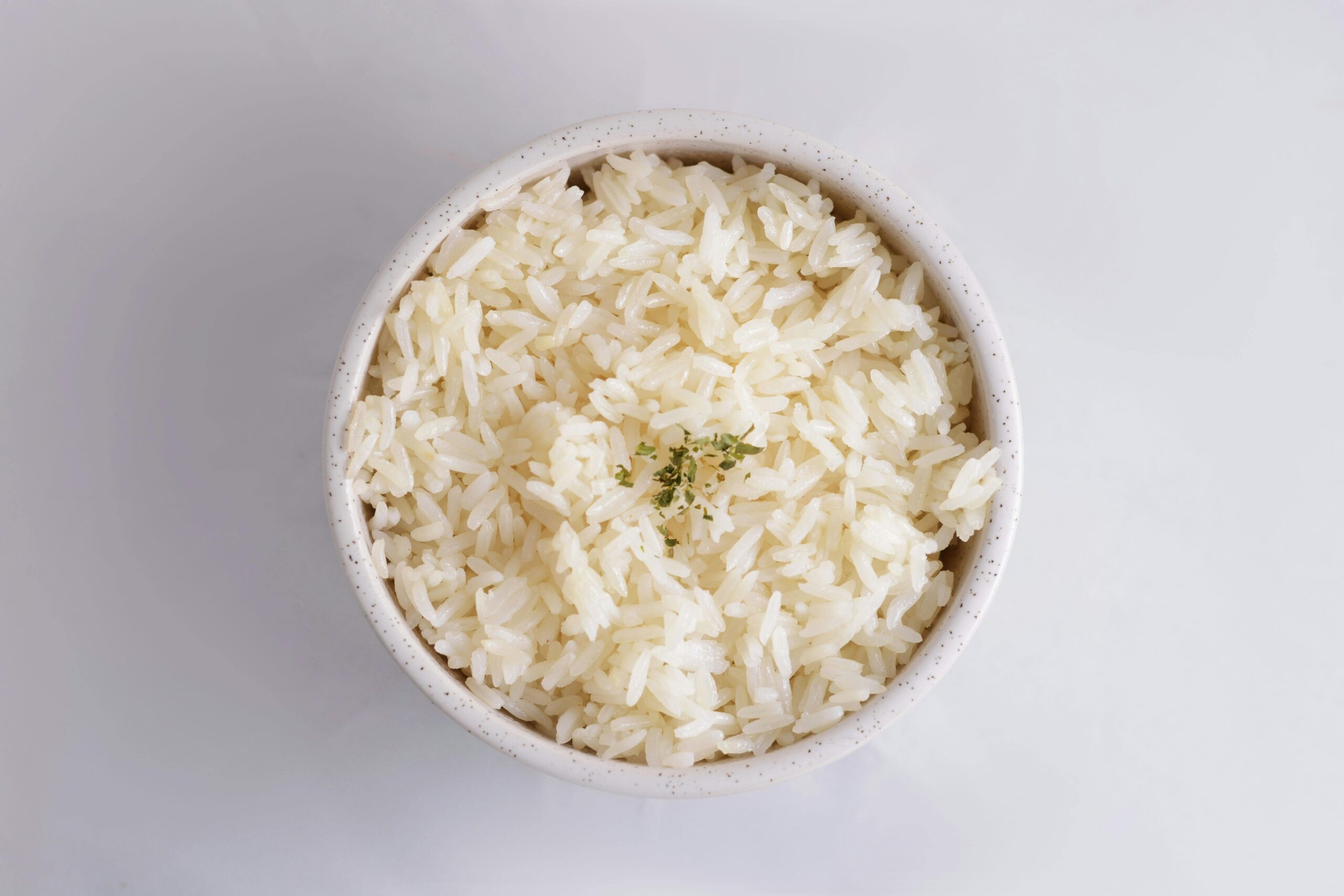Steamed rice is a fundamental staple in many cuisines worldwide and is known for its simplicity, versatility, and nutritional benefits. It is a blank canvas that complements a wide variety of dishes, from savory to sweet, making it a cornerstone of countless meals across different cultures.
If you’ve ever cooked white rice and it turned out sticky, undercooked, or stuck to the bottom of the pan, you’re not alone. We’ve all been there. In fact, I used to avoid cooking rice for this very reason, chalking my failures up to not owning a rice cooker.
However, since then I’ve perfected my go-to method for cooking white rice that’s fluffy, tender, and delicious every time. Plus, it just requires a saucepan and lid (no fancy rice cooker). Let me show you how it’s done.
Preparation
This is typically prepared by rinsing raw rice to remove excess starch, which helps in achieving a fluffy texture once cooked. The rice is then boiled or steamed in water until the grains absorb the moisture and become tender yet firm to the bite. This cooking method ensures that each grain remains separate and retains its shape.
Cultural Significance:
In Asian cultures, particularly in East Asia and Southeast Asia, rice holds deep cultural and symbolic significance. It often symbolizes prosperity, fertility, and even spiritual connectedness. It’s a staple in daily meals and is treated with great respect, sometimes even considered a gift from the gods.
Nutritional Value:
Nutritionally, steamed rice is predominantly a source of carbohydrates, which provide energy essential for daily activities. It’s low in fat and cholesterol, making it a healthy choice when consumed in moderation. Brown rice, a less processed variety, retains more nutrients and fiber compared to white rice, offering additional health benefits.
Versatility in Cuisine
Steamed rice’s neutral flavor profile allows it to pair effortlessly with various dishes. In Asian cuisine, it accompanies stir-fries, curries, Grilled Chicken, Seafood, and Butter Chicken. It can also be flavored with herbs, spices, or sauces to enhance its taste and complement different dishes.
Global Variations
Different regions have their preferred types of rice and methods of preparation. For example, jasmine rice in Thailand is known for its fragrant aroma, while basmati rice from India and Pakistan has a distinctive long grain and nutty flavor. In Latin America, rice is often cooked with additional ingredients like beans or vegetables, creating dishes like rice and beans.
Health Considerations
While steamed rice is generally healthy, it’s important to be mindful of portion sizes, especially for those managing blood sugar levels or trying to control their weight. Choosing whole grain varieties like brown or black rice can provide more fiber and nutrients compared to white rice.
Cooking Techniques For Rice
The cooking process varies slightly depending on the type of rice and the desired texture. Some methods involve soaking the rice before cooking to shorten the cooking time and improve texture. Others may include adding coconut milk or other liquids for added flavor.
Also, try this:

INGREDIENTS:
- 1 cup of white rice (Other Rice like jasmine, basmati, or long-grain white)
- 1 3/4 cups of water (adjust as needed based on rice type and desired texture)
- Optional: 1/2 teaspoon of salt (to taste)
Equipment For Rice
- Medium-sized saucepan with a tight-fitting lid
- Fork or paddle for fluffing
How To Make:
1. Rinse The Rice
- Measure 1 cup of white rice and place it in a fine mesh sieve or strainer.
- Rinse the rice under cold water, gently swishing it around with your fingers. This helps remove excess starch from the rice grains, which can cause them to stick together.
2. Combine The Rice And Water
- Transfer the rinsed rice into the saucepan.
- Add 1 3/4 cups of water to the saucepan. Optionally, add salt to taste and stir gently to distribute.
3. Bring To Boil The Rice
- Place the saucepan over medium-high heat and bring the water to a rolling boil. This usually takes about 5-7 minutes.
4. Simmer And Cover
- Once the water is boiling, reduce the heat to low to maintain a gentle simmer.
- Immediately cover the saucepan with the lid. If your lid isn’t tight-fitting, you can place a clean kitchen towel or a layer of aluminum foil over the pot before covering it to trap steam effectively.
6. Cook The Rice
- Let the rice simmer, covered, for about 15-20 minutes. The exact timing will depend on your stove and the type of rice used.
- Avoid lifting the lid or stirring the rice during cooking, as this can disrupt the steaming process and affect the texture.
7. Resting Period
- Once the cooking time is complete, remove the saucepan from the heat.
- Keep the lid on and let the rice rest undisturbed for an additional 5-10 minutes. This allows the rice to finish steaming and absorb any remaining moisture, resulting in fluffy grains.
8. Fluff And Serve
- After resting, uncover the saucepan and use a fork or rice paddle to gently fluff the rice. This helps separate the grains and prevents clumping.
- Serve the fluffy white rice hot as a side dish or serve it with Butter Chicken and Grilled Chicken.
Tips For Success
- Use the correct water ratio for the type of rice you are using. Different varieties may require slightly different amounts of water.
- Maintain a gentle simmer once the water comes to a boil to ensure even cooking without burning the rice.
- Letting the rice rest off the heat after cooking is crucial for achieving a perfect texture.
- Resisting the urge to peek or stir during cooking and resting ensures the best results.
- With these steps, you can confidently cook fluffy and tender white rice every time, using just a basic saucepan and lid.
- It’s a simple yet essential skill that opens up a world of culinary possibilities!
foodie tours.in
Good food, Good mood..! 🙂

Leave a Reply